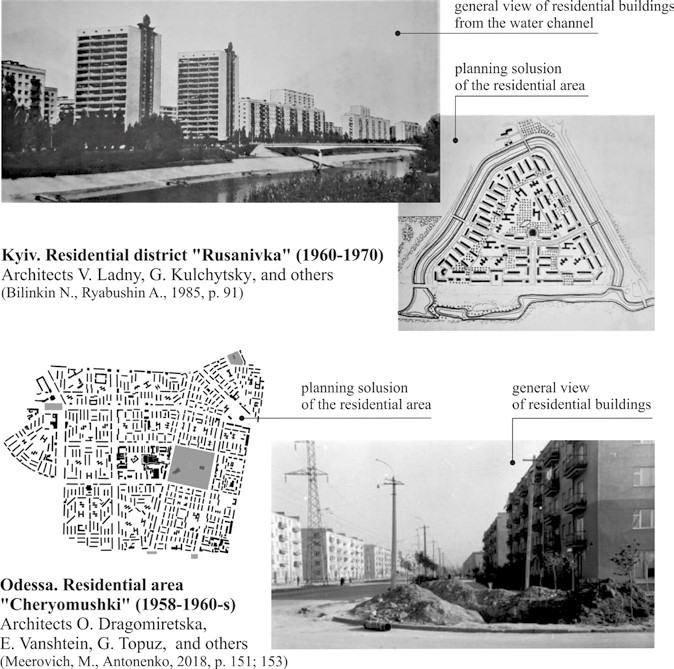Downloads
DOI:
https://doi.org/10.52200/docomomo.67.08Keywords:
Mass housing, industrial housing construction, typification, unification, constructive solutionAbstract
The housing issue is rightly considered one of the most acute problems of humankind. It is generated by social causes and has a social meaning. The housing issue cannot be solved with purely technical, architectural or artistic approaches. Rather, it also depends significantly on economic, political and environmental circumstances. At different times, the nature of the living environment was formed under the influence of social order, the level of development of productive forces, household and economic systems, and other factors. In the second half of the 20th century, following standard designs, Ukrainian cities mostly consisted of four- and five-story residential buildings in new residential areas. As a result, the living environment of many cities in the country acquired a common and rather modest appearance, dominated by concrete construction. At that time, this was the most effective way of mass housing construction. New technologies and design solutions were used. Such housing was cheap and purposefully met the social standards at the time. In addition, for the owners of such housing, it meant a new higher level of comfort. This publication focusses on housing construction in the second half of the 20th century in Ukraine after 1956. It is important to identify the quality of such housing and its compliance with modern requirements. Methods of systematization of historiographical materials, comparative and historical analysis, and field surveys were used to achieve the aim. Among the main achievements are the comfortable density of residential areas and fast construction times. The disadvantages of this period’s mass housing construction are related to missing maintenance, ongoing destruction, often complex ownership situations and the challenge to adapt each building to current needs and regulations.
How to Cite
Published
Issue
Section
License
Copyright (c) 2022 Liudmyla Shevchenko

This work is licensed under a Creative Commons Attribution 4.0 International License.
Plaudit
References
BACHYNSKA, L. G. (2004). The architecture of the dwelling. Problems of theory and practice of structure creation, Gramota, Kyiv.
BANYKIN, B.N. (1963). Design and construction of large-panel houses, Gostroyizdat, Moscow.
BILINKIN, N. & Ryabushin, A. (Eds.). (1985). Modern Soviet architecture, Stroyizdat, Moscow.
BOYCHENKO, A.M., Ginzburg, Sh.M., Zherdetsky, P.F. & Prisedko, B.S. (1961). Construction of residential buildings from large panels. From the experience of Glavkievstroy, Gosstroyizdat, Moscow.
CHERIKOVER, L.Z. (1944). Types and dimensions of kitchen equipment and the layout of kitchens of small apartments, Publishing House of the Academy of Architecture of the USSR, Moscow.
DYOMIN, M. & Byvalina, M. (2005). Locality and social and economic nutrition of the reconstruction of the territory of the five-overhead large-panel forgetfulness. In Mistobuduvannya and territorial planning, Vol: 20, pp. 90-94.
ELIZAROV, V.D. & Medvedeva, M.I. (Eds.) (1961). Large-panel housing construction, Gosstroyizdat of the Ukrainian SSR, Kyiv.
INOZEMTSEVA, A.S., Mulyar, L.Kh., Piskovskii, Yu.I. & Solovyov, V.P. (1988). Housing construction in the Ukrainian SSR, Budivelnyk, Kyiv.
GABREL, M.М. (2016). Problems and principles of humanizing the residential environment of microdistricts built in the 70s of the 20th century. In Modern problems of architecture and urban planning, Vol: 45, pp. 160-169.
KOROL, V.P. (2006). Architectural design of housing: a study guide, Fenix, Kyiv.
KYIV REAL ESTATE. (2018). http://kievbuilding.com.ua/index.php/about Accessed Jan. 15, 2019.
LAVRIK, G.I. (2007). Methods for assessing the quality of housing. Research, design, expertise: Textbook for universities, BSTU n.a. V.G. Shukhov, Belgorod.
LISITSIAN, M.V. & Pronina, E.S. (1990). Architectural design of residential buildings, Stroyizdat, Moscow.
LIVEJOURNAL (2016). Housing construction in the USSR and the RSFSR from 1918 to 1990. https://burckina-faso.livejournal.com/1527935.html Accessed Feb. 07, 2019.
MALAIA, K. (2021). Transforming the Architecture of Food: From the Soviet to the Post-Soviet Apartment. In JSAH, December, Vol: 80, Issue 4, pp. 460-476.
MEEROVICH, M. & Antonenko, N. (2018). Initial phase of khrushchevsky housing re-forming in Ukraine (on the example of residential area Cheryomushki, Odessa). In Scientific Bulletin of Construction, pp. 145-155.
POSOKHIN, M.M. (1953). Architecture of large-panel buildings. From design experience, Moscow worker, Moscow.
ROZANOV, N.P. (1982). Large-panel housing construction, Stroyizdat, Moscow.
RUDAKOV, P.G. & Fedorov E.P. (1964). Urban housing construction. Experience in the application of standard projects, Construction Literature Publishing House, Moscow.
SCHREIBER, A.K. (1993). Technical and economic assessment of options for organizational and technological solutions in the design and reconstruction of residential buildings. In Construction Economics, Vol. 3, pp. 25-27.
SHEVCHENKO, L.S. (2020). Second life of the residential building area of the middle of the 50s—Early 80s of the twentieth century in Ukraine: Opportunities and perspectives. doi:10.1007/978-3-030-42939-3_45.





